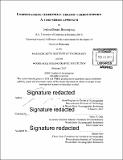| dc.contributor.advisor | Valier V. Galy. | en_US |
| dc.contributor.author | Hemingway, Jordon Dennis | en_US |
| dc.contributor.other | Woods Hole Oceanographic Institution. | en_US |
| dc.date.accessioned | 2017-05-12T19:00:49Z | |
| dc.date.available | 2017-05-12T19:00:49Z | |
| dc.date.copyright | 2017 | en_US |
| dc.date.issued | 2017 | en_US |
| dc.identifier.uri | http://hdl.handle.net/1721.1/109054 | |
| dc.description | Thesis: Ph. D., Joint Program in Chemical Oceanography (Massachusetts Institute of Technology, Department of Earth, Atmospheric, and Planetary Sciences; and the Woods Hole Oceanographic Institution), 2017. | en_US |
| dc.description | Cataloged from PDF version of thesis. | en_US |
| dc.description | Includes bibliographical references (pages 169-190). | en_US |
| dc.description.abstract | Terrestrial organic carbon (OC) erosion, remineralization, transport through river networks, and burial in marine sediments is a major pathway of the global carbon cycle. However, our ability to constrain these processes and fluxes is largely limited by (i) analytical capability and (ii) temporal sampling resolution. To address issue (i), here I discuss methodological advancements and data analysis techniques for the Ramped PyrOx serial oxidation isotope method developed at WHOI. Ramped-temperature pyrolysis/oxidation coupled with the stable carbon (¹²C, ¹³C) and radiocarbon (¹⁴C) analysis of evolved CO₂ is a promising tool for understanding and separating complex OC mixtures. To quantitatively investigate distributions of OC source, reservoir age, and chemical structure contained within a single sample, I developed a kinetic model linking RPO-derived activation energy, ¹³C composition, and radiocarbon content. This tool provides a novel method to fundamentally address the unknown relationship between OC remineralization rates and chemical structure in various environmental settings. To address issue (ii), I additionally present results from time-series sample sets collected on two end-member systems: the Congo River (Central Africa) and the LiWu River (Taiwan). For the Congo River, bulk and plant-wax-lipid ¹³C compositions indicate that a majority of particulate OC is consistently derived from downstream, C₃-dominated rainforest ecosystems. Furthermore, bulk radiocarbon content and microbial lipid molecular distributions are strongly correlated with discharge, suggesting that pre-aged, swamp-forest-derived soils are preferentially exported when northern hemisphere discharge is highest. Combined, these results provide insight into the relationship between hydrological processes and fluvial carbon export. Lastly, I examined the processes controlling carbon source and flux in a set of soils and time-series fluvial sediments from the LiWu River catchment located in Taiwan. A comparison between bedrock and soil OC content reveals that soils can contain significantly less carbon than the underlying bedrock, suggesting that this material is remineralized to CO₂ prior to soil formation. Both the presence of bacterial lipids and a shift toward lower activation energy of ¹⁴C-free OC contained in soil saprolite layers indicate that this process is microbially mediated and that microbial respiration of rock-derived OC likely represents a larger geochemical flux than previously thought. The results presented in this thesis therefore provide novel insight into the role of rivers in the global carbon cycle as well as their response to environmental perturbations. | en_US |
| dc.description.statementofresponsibility | by Jordon Dennis Hemingway | en_US |
| dc.format.extent | 190 pages | en_US |
| dc.language.iso | eng | en_US |
| dc.publisher | Massachusetts Institute of Technology | en_US |
| dc.rights | MIT theses are protected by copyright. They may be viewed, downloaded, or printed from this source but further reproduction or distribution in any format is prohibited without written permission. | en_US |
| dc.rights.uri | http://dspace.mit.edu/handle/1721.1/7582 | en_US |
| dc.subject | Joint Program in Chemical Oceanography. | en_US |
| dc.subject | Earth, Atmospheric, and Planetary Sciences. | en_US |
| dc.subject | Woods Hole Oceanographic Institution. | en_US |
| dc.subject.lcsh | Carbon | en_US |
| dc.subject.lcsh | Marine sediments | en_US |
| dc.title | Understanding terrestrial organic carbon export : a time-series approach | en_US |
| dc.type | Thesis | en_US |
| dc.description.degree | Ph. D. | en_US |
| dc.contributor.department | Joint Program in Chemical Oceanography | en_US |
| dc.contributor.department | Woods Hole Oceanographic Institution | en_US |
| dc.contributor.department | Massachusetts Institute of Technology. Department of Earth, Atmospheric, and Planetary Sciences | |
| dc.identifier.oclc | 986241132 | en_US |
